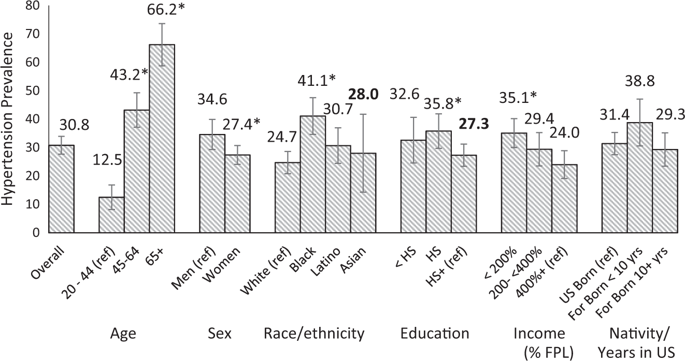当前位置:
X-MOL 学术
›
J. Hum. Hypertens.
›
论文详情
Our official English website, www.x-mol.net, welcomes your
feedback! (Note: you will need to create a separate account there.)
Lower 24-h urinary sodium excretion is associated with hypertension control: the 2010 Heart Follow-Up Study.
Journal of Human Hypertension ( IF 2.7 ) Pub Date : 2019-11-11 , DOI: 10.1038/s41371-019-0285-9 Tali Elfassy 1 , Shadi Chamany 2 , Katherine Bartley 2 , Stella S Yi 3 , Sonia Y Angell 2
Journal of Human Hypertension ( IF 2.7 ) Pub Date : 2019-11-11 , DOI: 10.1038/s41371-019-0285-9 Tali Elfassy 1 , Shadi Chamany 2 , Katherine Bartley 2 , Stella S Yi 3 , Sonia Y Angell 2
Affiliation

|
Among individuals with hypertension, controlling high blood pressure (BP) reduces the risk for cardiovascular events and death. Reducing dietary sodium can help achieve BP control. The study aim was to use a population-based sample utilizing the gold standard for urinary sodium to quantify the degree with which sodium was independently associated with BP control among individuals with hypertension. Participants included 1568 adults from the Heart Follow-Up Study, a New York City population-based representative study conducted in 2010. Participants collected urine for 24 h and had BP and other anthropometrics measured. Hypertension was defined as systolic BP ≥ 140 mmHg, diastolic BP ≥ 90 mmHg, or being on BP lowering medication. Sodium intake (mg/day) was measured from a single 24-h urine collection. Hypertension prevalence was 30.8%. Among those with hypertension, 64.6% were aware, 56.3% were treated, and 40.3% were controlled. Among those treated for hypertension, 73.0% were controlled. Mean sodium intake among those with hypertension was 3564 mg/day. From multivariable adjusted logistic regression models, each 500 mg decrease in 24-h urinary sodium excretion was associated with a 18% higher odds of hypertension control among those with hypertension (1.18, 95% CI: 1.07, 1.30). In New York City, approximately one in three people has hypertension with a majority uncontrolled. Sodium intake among those with hypertension was 55% greater than recommended upper limit of 2300 mg per day. Among individuals with hypertension, lower sodium intake was associated with hypertension control.
中文翻译:

较低的 24 小时尿钠排泄与高血压控制有关:2010 年心脏随访研究。
在高血压患者中,控制高血压 (BP) 可降低心血管事件和死亡的风险。减少饮食中的钠元素有助于控制血压。该研究的目的是使用基于人群的样本,利用尿钠的金标准来量化钠与高血压个体的血压控制独立相关的程度。参与者包括来自心脏随访研究的 1568 名成年人,该研究是 2010 年进行的一项基于纽约市人口的代表性研究。参与者收集了 24 小时的尿液,并测量了血压和其他人体测量学。高血压定义为收缩压 ≥ 140 mmHg、舒张压 ≥ 90 mmHg 或正在服用降压药物。钠摄入量(mg/天)是从单次 24 小时尿液收集中测量的。高血压患病率为 30.8%。高血压患者中64.6%知晓,56.3%得到治疗,40.3%得到控制。在接受高血压治疗的患者中,73.0% 的患者得到控制。高血压患者的平均钠摄入量为 3564 毫克/天。根据多变量调整逻辑回归模型,24 小时尿钠排泄量每减少 500 毫克,高血压患者的高血压控制几率就会增加 18%(1.18,95% CI:1.07,1.30)。在纽约市,大约三分之一的人患有高血压,而且大多数人不受控制。高血压患者的钠摄入量比每天 2300 毫克的推荐上限高 55%。在高血压患者中,较低的钠摄入量与高血压控制有关。在接受高血压治疗的患者中,73.0% 的患者得到控制。高血压患者的平均钠摄入量为 3564 毫克/天。根据多变量调整逻辑回归模型,24 小时尿钠排泄量每减少 500 毫克,高血压患者的高血压控制几率就会增加 18%(1.18,95% CI:1.07,1.30)。在纽约市,大约三分之一的人患有高血压,而且大多数人不受控制。高血压患者的钠摄入量比每天 2300 毫克的推荐上限高 55%。在高血压患者中,较低的钠摄入量与高血压控制有关。在接受高血压治疗的患者中,73.0% 的患者得到控制。高血压患者的平均钠摄入量为 3564 毫克/天。从多变量调整逻辑回归模型中,24 小时尿钠排泄量每减少 500 毫克,高血压患者的高血压控制几率就会增加 18%(1.18,95% CI:1.07,1.30)。在纽约市,大约三分之一的人患有高血压,而且大多数人不受控制。高血压患者的钠摄入量比每天 2300 毫克的推荐上限高 55%。在高血压患者中,较低的钠摄入量与高血压控制有关。24 小时尿钠排泄量每减少 500 毫克,高血压患者的高血压控制几率就会增加 18%(1.18,95% CI:1.07,1.30)。在纽约市,大约三分之一的人患有高血压,而且大多数人不受控制。高血压患者的钠摄入量比每天 2300 毫克的推荐上限高 55%。在高血压患者中,较低的钠摄入量与高血压控制有关。24 小时尿钠排泄量每减少 500 毫克,高血压患者的高血压控制几率就会增加 18%(1.18,95% CI:1.07,1.30)。在纽约市,大约三分之一的人患有高血压,而且大多数人不受控制。高血压患者的钠摄入量比每天 2300 毫克的推荐上限高 55%。在高血压患者中,较低的钠摄入量与高血压控制有关。
更新日期:2019-11-11
中文翻译:

较低的 24 小时尿钠排泄与高血压控制有关:2010 年心脏随访研究。
在高血压患者中,控制高血压 (BP) 可降低心血管事件和死亡的风险。减少饮食中的钠元素有助于控制血压。该研究的目的是使用基于人群的样本,利用尿钠的金标准来量化钠与高血压个体的血压控制独立相关的程度。参与者包括来自心脏随访研究的 1568 名成年人,该研究是 2010 年进行的一项基于纽约市人口的代表性研究。参与者收集了 24 小时的尿液,并测量了血压和其他人体测量学。高血压定义为收缩压 ≥ 140 mmHg、舒张压 ≥ 90 mmHg 或正在服用降压药物。钠摄入量(mg/天)是从单次 24 小时尿液收集中测量的。高血压患病率为 30.8%。高血压患者中64.6%知晓,56.3%得到治疗,40.3%得到控制。在接受高血压治疗的患者中,73.0% 的患者得到控制。高血压患者的平均钠摄入量为 3564 毫克/天。根据多变量调整逻辑回归模型,24 小时尿钠排泄量每减少 500 毫克,高血压患者的高血压控制几率就会增加 18%(1.18,95% CI:1.07,1.30)。在纽约市,大约三分之一的人患有高血压,而且大多数人不受控制。高血压患者的钠摄入量比每天 2300 毫克的推荐上限高 55%。在高血压患者中,较低的钠摄入量与高血压控制有关。在接受高血压治疗的患者中,73.0% 的患者得到控制。高血压患者的平均钠摄入量为 3564 毫克/天。根据多变量调整逻辑回归模型,24 小时尿钠排泄量每减少 500 毫克,高血压患者的高血压控制几率就会增加 18%(1.18,95% CI:1.07,1.30)。在纽约市,大约三分之一的人患有高血压,而且大多数人不受控制。高血压患者的钠摄入量比每天 2300 毫克的推荐上限高 55%。在高血压患者中,较低的钠摄入量与高血压控制有关。在接受高血压治疗的患者中,73.0% 的患者得到控制。高血压患者的平均钠摄入量为 3564 毫克/天。从多变量调整逻辑回归模型中,24 小时尿钠排泄量每减少 500 毫克,高血压患者的高血压控制几率就会增加 18%(1.18,95% CI:1.07,1.30)。在纽约市,大约三分之一的人患有高血压,而且大多数人不受控制。高血压患者的钠摄入量比每天 2300 毫克的推荐上限高 55%。在高血压患者中,较低的钠摄入量与高血压控制有关。24 小时尿钠排泄量每减少 500 毫克,高血压患者的高血压控制几率就会增加 18%(1.18,95% CI:1.07,1.30)。在纽约市,大约三分之一的人患有高血压,而且大多数人不受控制。高血压患者的钠摄入量比每天 2300 毫克的推荐上限高 55%。在高血压患者中,较低的钠摄入量与高血压控制有关。24 小时尿钠排泄量每减少 500 毫克,高血压患者的高血压控制几率就会增加 18%(1.18,95% CI:1.07,1.30)。在纽约市,大约三分之一的人患有高血压,而且大多数人不受控制。高血压患者的钠摄入量比每天 2300 毫克的推荐上限高 55%。在高血压患者中,较低的钠摄入量与高血压控制有关。











































 京公网安备 11010802027423号
京公网安备 11010802027423号